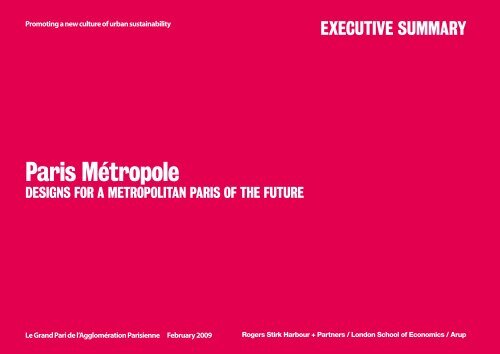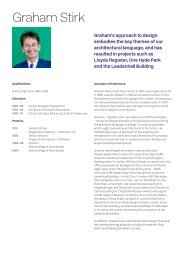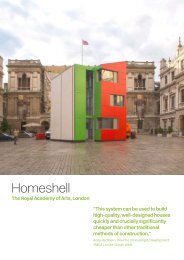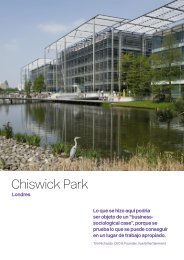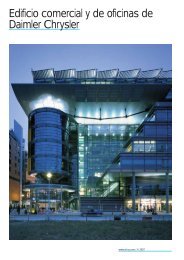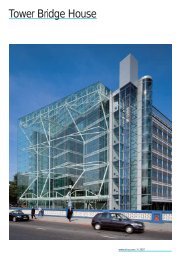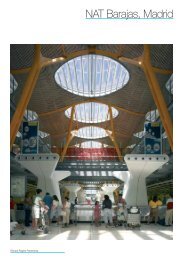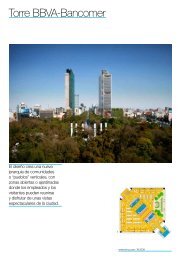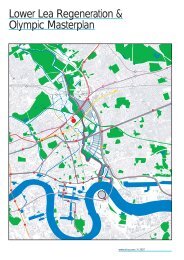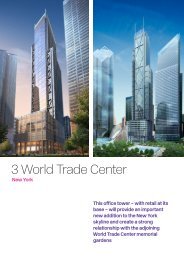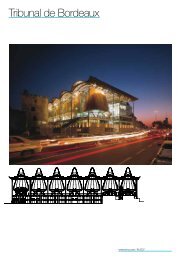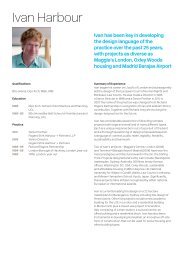Grand Paris Executive Summary (PDF 31MB) - Rogers Stirk Harbour ...
Grand Paris Executive Summary (PDF 31MB) - Rogers Stirk Harbour ...
Grand Paris Executive Summary (PDF 31MB) - Rogers Stirk Harbour ...
Create successful ePaper yourself
Turn your PDF publications into a flip-book with our unique Google optimized e-Paper software.
Promoting a new culture of urban sustainability<br />
EXECUTIVE SUmmarY<br />
<strong>Paris</strong> Métropole<br />
DESIGNS FOR A METROPOLITAN PARIS OF THE FUTURE<br />
Le <strong>Grand</strong> Pari de l’Agglomération <strong>Paris</strong>ienne February 2009<br />
<strong>Rogers</strong> <strong>Stirk</strong> <strong>Harbour</strong> + Partners / London School of Economics / Arup
Introduction<br />
<strong>Summary</strong><br />
To recognise world-wide ecological concerns and<br />
likely impacts of global sustainability strategies is<br />
an act of urban responsibility.<br />
To ask how your city can transform itself to better<br />
respond to a sustainable future and to commission<br />
work to study what can be done to achieve that<br />
objective, is an act of vision and belief.<br />
The French Government, the City of <strong>Paris</strong> and<br />
the Île-de-France and its communes have shown<br />
foresight and leadership in launching this<br />
consultation on the question of ‘le <strong>Grand</strong> <strong>Paris</strong> de<br />
l’Avenir’ - not only in response to global ecological<br />
issues but also in terms of socio-economic<br />
imperatives, urban developmental priorities, the<br />
everyday needs and quality of life of its citizens, the<br />
creative and dynamic force of urban society.<br />
The commissioning of this study is statement of<br />
belief in the potential and strength of the future of<br />
greater <strong>Paris</strong>.<br />
It is an act of citizenship on a large scale.<br />
The Team applauds and respects that vision.<br />
<strong>Rogers</strong> <strong>Stirk</strong> <strong>Harbour</strong> + Partners has participated<br />
fully in the consultation and study processes of le<br />
<strong>Grand</strong> <strong>Paris</strong> and have debated with many expert<br />
voices and elected and designated representatives,<br />
in both formal and informal meetings and<br />
presentations.<br />
We have also participated alongside our fellow<br />
consultant teams - their work has informed and<br />
uplifted us.<br />
Of neccessity, given the resources and time scale in<br />
which to explore such a vast territory, RSHP’s work<br />
has focused on ideas, concepts and principles and<br />
not on fine detail - this detail must be the subject<br />
of further studies by expert hands in focused and<br />
specific areas.<br />
Many of the ideas and concepts raised by our<br />
team may appear controversial, unacceptable and<br />
unrealisable in that the perennial obstacles of cost,<br />
politics, socio- economic priorities and practical or<br />
technicial difficulties block their paths.<br />
This has always been the case - but history has<br />
also proved that ideas, new concepts and new<br />
paradigms do emerge, survive, blossom and add to<br />
the fabric and the life of the city.<br />
The impossible often becomes possible - the<br />
unimaginable regularly becomes reality.<br />
Metropolitan <strong>Paris</strong> has the power, the expertise and<br />
the will to adapt to its emerging longer-term needs.<br />
This is in evidence across the <strong>Paris</strong> region today.<br />
Change is everywhere around us.<br />
<strong>Paris</strong> will adapt to the challenges ahead, becoming<br />
le <strong>Grand</strong> <strong>Paris</strong> of tomorrow, a <strong>Grand</strong> <strong>Paris</strong> better<br />
equipped to face the ecological, socio-economic<br />
and urban challenges of the future city.<br />
Clear vision, good strategic thinking, high quality<br />
design and environment, and constructive<br />
citizenship will play a fundamental part in the<br />
quality of life and sustainable success of le <strong>Grand</strong><br />
<strong>Paris</strong>.<br />
We thank them for the participatory dissemination<br />
of their visions during the consultation process.<br />
We believe that the reflections of their and our<br />
own teams will enrich and catalyse further debate,<br />
decision-making and action on the future of le<br />
<strong>Grand</strong> <strong>Paris</strong>.<br />
Mike Davies CBE<br />
<strong>Rogers</strong> <strong>Stirk</strong> <strong>Harbour</strong> + Partners<br />
London, February 2009<br />
ii <strong>Rogers</strong> <strong>Stirk</strong> <strong>Harbour</strong> + Partners / London School of Economics / Arup<br />
February 2009
<strong>Summary</strong><br />
<strong>Rogers</strong> <strong>Stirk</strong> <strong>Harbour</strong> + Partners / London School of Economics / Arup<br />
February 2009<br />
iii
1 - Restructuring metropolitan<br />
governance in Île-de-France<br />
The major problem facing the Île-de-France region<br />
is the fragmentation of its governance structure,<br />
which prevents it from implementing strategic<br />
action on a metropolitan scale.<br />
The domination of the <strong>Paris</strong> metropolis by its<br />
centre, which exerts considerable influence and<br />
power over the whole metropolis, may reflect the<br />
history of the city but it does not reflect its current<br />
situation at the dawn of the 21st century.<br />
9/11ths of the citizens of the Île-de-France region<br />
live outside of the centre of <strong>Paris</strong> but speak only<br />
with a fragmented voice. The City of <strong>Paris</strong>, with<br />
its 2.1 million inhabitants, enjoys representation<br />
through its Mayor and is therefore capable of<br />
undertaking coordinated action inside of the ringroad.<br />
Its clear voice also gives the City of <strong>Paris</strong> an<br />
important influence at a regional level - which is,<br />
perhaps, disproportionate compared to the rest of<br />
the city.<br />
The considerable asset in terms of the effectiveness<br />
of the local action that the 1,280 Mayors of the Îlede-France<br />
region represent is often drowned out by<br />
the difficulties encountered when a strategic vision<br />
has to be developed for an area beyond communal<br />
borders and the local quarrels that this engenders.<br />
The “Conseil Régional” (regional council) plays<br />
an important role but suffers from a weak<br />
coercive power. It has the significant challenge of<br />
understanding and coordinating the very different<br />
needs of rural communities located 90 km from<br />
the centre and those of various groups living in the<br />
heart of metropolitan <strong>Paris</strong>. Added to this a State<br />
that, despite separating itself from some functions,<br />
maintains a very significant presence in the Region.<br />
It is therefore understandable why the governance<br />
in Île-de-France is considered an administrative<br />
“mille-feuille”, slowing down the metropolitan<br />
action that is crucial for preparing metropolitan<br />
<strong>Paris</strong> for the 21st century.<br />
The three scenarios we have proposed aim to<br />
rebalance the governance structure in Île-de-<br />
France, making possible governance that is both<br />
coordinated and holistic for the metropolis, and<br />
ensuring that the voices of the metropolitan region<br />
outside the centre are heard.<br />
“I don’t know of any<br />
other city where the<br />
heart is as detached<br />
from its limbs”<br />
Richard <strong>Rogers</strong><br />
<strong>Summary</strong><br />
The spontaneous formation of “Communautés<br />
d’Agglomération” (Communes grouping together)<br />
is an effective response to these problems, as this<br />
allows a group of municipalities to reach a critical<br />
mass in terms of both population and influence,<br />
thereby allowing it to have a voice that is strong<br />
enough to be heard on a metropolitan level and<br />
not be overwhelmed by the City of <strong>Paris</strong>.<br />
iv <strong>Rogers</strong> <strong>Stirk</strong> <strong>Harbour</strong> + Partners / London School of Economics / Arup<br />
February 2009
<strong>Summary</strong><br />
2009 2015<br />
Historicity<br />
A.<br />
Expansion of the principle of<br />
intercommunality and creation on a<br />
long-term basis of eight “Communautés<br />
d’Agglomération” with powers and a structure<br />
similar to those the City of <strong>Paris</strong> has today.<br />
Progressive disengagement of the State in the<br />
management of regional affairs.<br />
Democratic Integration<br />
B.<br />
Creation of 23 administrative entities, each<br />
with a similar population, in the region of<br />
Île-de-France. The City of <strong>Paris</strong> is divided up<br />
and the areas distributed within the zone of<br />
the “première couronne” (the départements<br />
surrounding the City of <strong>Paris</strong>). A strong<br />
metropolitan government strategically<br />
coordinates the action on a regional scale.<br />
Urban-Rural Coexistence<br />
Île-de-France is divided into two sub-regional<br />
governments. The urban municipalities are<br />
separated from the rural municipalities.<br />
Regional coordination is carried out through a<br />
coordination committee.<br />
C.<br />
<strong>Rogers</strong> <strong>Stirk</strong> <strong>Harbour</strong> + Partners / London School of Economics / Arup<br />
February 2009<br />
v
2 - BUILDING PARIS ON PARIS<br />
<strong>Summary</strong><br />
Compactness has to be the first rule of<br />
contemporary urban design. It is a concept that<br />
generates efficiency, interaction and urbanity.<br />
Building the city on the city is to recognise the true<br />
value of the land.<br />
2009<br />
Proximity produces efficiency, interaction and<br />
interchange.<br />
25 km<br />
In terms of mobility and transport, compactness<br />
reduces journey distances and times. Energy<br />
costs, network losses and ecological footprint are<br />
consequently minimised.<br />
1850<br />
Socially, the citizens of the metropolis are brought<br />
together and from this proximity they will gain both<br />
a communal and cultural benefit. The concentration<br />
of people together gives better returns on<br />
investments in the infrastructure, transport and<br />
facilities.<br />
The first step consists in precisely identifying<br />
brownfield land. The abandoned or underexploited<br />
sites of the city will tomorrow have an<br />
inestimable value. These need to be developed in<br />
a strategic way with the perspective of maximising<br />
their long-term contribution to the metropolis.<br />
What seems impossible today will be necessary<br />
tomorrow.<br />
1900<br />
The second step consists in reinforcing a protected<br />
green belt, which will clearly define the boundaries<br />
of the city and limit its uncontrolled expansion.<br />
We propose a metropolitan <strong>Paris</strong> that is more<br />
compact, more concentrated and more efficient.<br />
1. The urban footprint of the <strong>Paris</strong> Metropolis has spread without constraint over time. Green spaces have<br />
been absorbed by an urban periphery with no clear boundary. The low density and long distances that<br />
result from this are neither efficient nor sustainable over the long-term.<br />
1965<br />
vi <strong>Rogers</strong> <strong>Stirk</strong> <strong>Harbour</strong> + Partners / London School of Economics / Arup<br />
February 2009
<strong>Summary</strong><br />
1,000 hectares of brown field<br />
land in Île-de-France*<br />
2015<br />
2. The existing urban footprint is capable of absorbing a very considerable part of urban growth. Land<br />
that is un- or under-used needs to be identified, and a coordinated development strategy needs to be<br />
implemented for its inclusion and intensification.<br />
3. The relentless expansion of the city needs to be controlled. The creation of a green belt protected by<br />
law is a key mechanism to limit this expansion. Not only does this ensure that new developments will<br />
be concentrated inside the existing urban footprint, but it also allows the natural heritage of the city’s<br />
hinterland to be conserved in the long term.<br />
* Direction Régionale de l’Équipement (Oliver, Ferber, Grimski, Millar and Nathanial “The Scale and Nature of European<br />
Brownfields” 2005) / * 140ha de friches industrielles en Première Couronne (140ha of industrial wasteland in the “Première<br />
Couronne”) - ECODEV May 2008<br />
<strong>Rogers</strong> <strong>Stirk</strong> <strong>Harbour</strong> + Partners / London School of Economics / Arup<br />
February 2009<br />
vii
3 - Completing the public transport<br />
networkS of the metropolis<br />
Some 70% of the daily commutes in the<br />
metropolitan region today are from suburb<br />
to suburb, by-passing the centre of the city<br />
completely. For these citizens, travelling by car is<br />
often the only practical transport option.<br />
We propose an extension that will link La Défense<br />
to the national and European high-speed train<br />
network and that will recognise and strengthen the<br />
important role that this business district plays in the<br />
region.<br />
<strong>Summary</strong><br />
Public transport is predominantly organised<br />
according to a radio-centric model, which obliges<br />
commuters to pass through the centre, causing an<br />
overload of the inner-city networks during rush<br />
hours.<br />
Of all the large cities in the world, <strong>Paris</strong> has one<br />
of the best public transport systems. However,<br />
this system, by not taking account of the needs<br />
of the population living outside the centre,<br />
has not evolved in the same way as its urban<br />
agglomeration: 70% of the population today is<br />
poorly served by the metropolis’s public transport<br />
network.<br />
In the long term, this situation is not sustainable<br />
and slows down the growth and economic<br />
efficiency of the metropolis. The loss of time<br />
resulting from journeys that are potentially<br />
avoidable also has a social cost and a significant<br />
impact on the quality of life in the city.<br />
This link will allow interconnections with the<br />
airports of <strong>Paris</strong>, CDG and Orly, and will link the TGV<br />
Atlantique network to Massy, creating a new TGV<br />
axis to the west of <strong>Paris</strong>.<br />
In the medium term, it is also essential to address<br />
the question of private transport “door to door” -<br />
the car.<br />
We put forward a series of ideas dealing with the<br />
environmental impact and decongestion of the<br />
urban road network, and at the same time aiming<br />
for the necessary change towards a metropolitan<br />
<strong>Paris</strong> that is less dependent on the car.<br />
Finally, we are aiming to integrate freight into the<br />
public transport network by creating multimodal<br />
interchanges. These will be integrated into the<br />
metropolitan armatures we are proposing.<br />
We therefore propose complementing the radiocentric<br />
network with a circumferential network<br />
linking the hubs and populations of the “première<br />
couronne”. The circumferential links will not be<br />
identical in capacity or cost. Local underground,<br />
tram and tram-train systems will complement each<br />
other in order to maximise the value and impact of<br />
investment in new systems.<br />
In time, the rings of this network will multiply to<br />
keep in line with the growth and densification of<br />
the metropolis.<br />
viii <strong>Rogers</strong> <strong>Stirk</strong> <strong>Harbour</strong> + Partners / London School of Economics / Arup<br />
February 2009
AÉROPORT<br />
DE<br />
PARIS-ORLY<br />
AÉROPORT DE PARIS<br />
LE BOURGET<br />
AÉROPORT DE PARIS<br />
CH. DE GAULLE<br />
AÉROPORT<br />
DE<br />
PARIS-ORLY<br />
AÉROPORT DE PARIS<br />
LE BOURGET<br />
AÉROPORT DE PARIS<br />
CH. DE GAULLE<br />
<strong>Summary</strong><br />
2009<br />
2020<br />
1. Reflecting the historic importance of the City of <strong>Paris</strong>, the public transport networks are organised in<br />
a system of radial connections. This organisation does not reflect the growth of the metropolis, nor<br />
the fact that 70% of daily commutes do not pass through the city centre. The Francilians (living in the<br />
Île-de-France region), poorly served by public transport are often forced to use the peripheral road<br />
network to commute, a solution that is far from sustainable and that causes serious congestion on the<br />
roads during rush hours. There is a corresponding negative impact on the environment and the quality<br />
of people’s lives.<br />
2. A massive investment in public transport networks is needed outside the centre of the metropolis. The<br />
priority has to be given to circumferential connections, with the final objective being the harmonisation<br />
of the services offered between the centre and the periphery.<br />
<strong>Rogers</strong> <strong>Stirk</strong> <strong>Harbour</strong> + Partners / London School of Economics / Arup<br />
February 2009<br />
ix
4 - Creating a polycentric metropolitan <strong>Paris</strong><br />
<strong>Summary</strong><br />
<strong>Paris</strong>’s strength is also its biggest weakness: The<br />
centre of the metropolis dominates the growth and<br />
balance of the periphery.<br />
The radiocentric structure of the city’s transport<br />
networks penalises the metropolitan population<br />
living outside the centre and congests its radial<br />
arteries.<br />
Defined in relation to a single centre, the metropolis<br />
presents an unequal relationship between the<br />
inner centre of <strong>Paris</strong> and the secondary hubs of<br />
metropolitan <strong>Paris</strong>.<br />
The movement of the population and jobs to<br />
outside the centre requires new relationships to<br />
be formed between <strong>Paris</strong> and its periphery at a<br />
political, economic and social scale.<br />
We propose a form of “compact polycentrism”,<br />
which will concentrate growth in the main hubs<br />
that exist already inside the “Petite Couronne”.<br />
These hubs will be better connected, as they will<br />
be situated at the key interchanges of a transport<br />
network that has been enhanced and balanced out<br />
by the circumferential links proposed.<br />
These new polycentres will be defined not only by<br />
their relationship with the centre but also by their<br />
relationship with the neighbouring hubs and the<br />
other centres of the region.<br />
The creation of polycentres is intimately connected<br />
with the creation of proximity, mixed use and social<br />
diversity.<br />
The distances to these new places of work and<br />
urban life will be reduced.<br />
All the elements necessary for urban life will be<br />
available in each hub in order to ensure a mix<br />
between work, domestic life and leisure.<br />
At the same time, each hub will develop a distinct<br />
character, reinforcing local identity and a feeling of<br />
belonging that is both metropolitan and local.<br />
A stronger, more polycentric metropolitan region<br />
does not mean a diminished <strong>Paris</strong>. On the contrary,<br />
<strong>Paris</strong> depends on the growth and the health of its<br />
periphery.<br />
x <strong>Rogers</strong> <strong>Stirk</strong> <strong>Harbour</strong> + Partners / London School of Economics / Arup<br />
February 2009
<strong>Summary</strong><br />
2009<br />
2030<br />
AÉROPORT DE PARIS<br />
CHARLES DE GAULLE<br />
St Denis<br />
AÉROPORT DE PARIS<br />
CHARLES DE GAULLE<br />
La Défense<br />
St Denis<br />
AÉROPORT DE PARIS<br />
LE BOURGET<br />
La Défense<br />
AÉROPORT DE PARIS<br />
LE BOURGET<br />
Noisy<br />
Noisy<br />
Massy<br />
AÉROPORT DE<br />
PARIS-ORLY<br />
Massy<br />
AÉROPORT DE<br />
PARIS-ORLY<br />
1. The centre of <strong>Paris</strong>, the historic heart of the region, is so strong it continues to dominate the metropolis.<br />
In reality, this monocentric representation of the city does not reflect the change taking place in the<br />
metropolis – the population and economic growth is happening outside the centre.<br />
2. The polycentric urban model recognises the importance of local centres and it is a more exact<br />
representation of how the majority of the region’s citizens live today. The vitality of the metropolis<br />
over the long term requires a rebalancing of the relationship between the centre and the periphery.<br />
Polycentres will grow around the pre-existing centres, anchored to the hubs of enhanced transport<br />
infrastructure.<br />
<strong>Rogers</strong> <strong>Stirk</strong> <strong>Harbour</strong> + Partners / London School of Economics / Arup<br />
February 2009<br />
xi
5 - BUILDING BALANCED COMMUNITIES<br />
<strong>Summary</strong><br />
The social disparities present in metropolitan <strong>Paris</strong><br />
are a major handicap for the region and for France.<br />
Communities in difficulty carry entire districts with<br />
them into spirals of isolation and economic and<br />
psycho-social depression.<br />
Intervention must be taken in a concerted and<br />
coordinated manner on a strategic level, but also<br />
in a practical manner on the ground itself at a local<br />
level.<br />
This is a major challenge which exceeds the<br />
capacity and means of the local municipalities and<br />
the powers of a single communal mayor.<br />
An ambitious national project is required, a “New<br />
Deal”.<br />
It is not a case of displacing communities and<br />
pushing them further from the centre. It is a case of<br />
sensitive integration - “Addition not substitution”<br />
This involves the use of strategies relating to<br />
proximity, social mix and connectivity.<br />
Local economies need to be stimulated and help is<br />
needed to develop local and specialised markets.<br />
The physical isolation of some of the deprived<br />
housing estates can directly generate the feeling of<br />
separation that some communities experience in<br />
relation to the rest of French society and create an<br />
insurmountable gap between these communities<br />
and the wealth that exists elsewhere in the <strong>Paris</strong><br />
region.<br />
We propose a Social Action Plan:<br />
••<br />
Encourage stable communities<br />
••<br />
Promote long-term links at the heart of the<br />
community between local public sector workers<br />
and the inhabitants of the deprived areas<br />
by rewarding those who work with difficult<br />
communities in highly exposed jobs - such as<br />
police officers, teachers, health care workers,<br />
local politicians and civil servants – with an<br />
increase in salary and status.<br />
••<br />
Recognise and support the active members<br />
of these communities and those who are<br />
considered as role models.<br />
••<br />
Encourage support networks<br />
••<br />
Make education a priority through the creation<br />
of exemplary schools that are open to all and<br />
adapted to the real needs of the communities<br />
they serve. Include technical training and the<br />
teaching of appropriate subjects and languages.<br />
••<br />
Reward regular school attendance<br />
••<br />
Ensure good transport access to support links to<br />
jobs, other communities and the city as a whole.<br />
••<br />
Enable access to local jobs, particularly for<br />
young people<br />
••<br />
Develop a community police service using local<br />
police stations. Promote the local recruitment of<br />
police officers and encourage the development<br />
of long-term relationships as well as the creation<br />
of familiarity with the communities they serve.<br />
••<br />
Provide the community with leisure facilities<br />
and places to meet e.g. sports facilities, music<br />
academies, cultural centres and community and<br />
training centres<br />
••<br />
Encourage communication between different<br />
generations<br />
••<br />
Ensure that the local socio-cultural facilities<br />
are affordable and accessible for the local<br />
population<br />
••<br />
Improve the quality of public spaces in the<br />
deprived areas<br />
••<br />
Consult the community on its needs<br />
••<br />
Offer quality architecture in the deprived areas<br />
that expresses respect and the desire to invest<br />
••<br />
Densify the areas in question through a prudent<br />
process of intensification<br />
••<br />
Provide housing that is adapted to demographic<br />
change, including large appartments for large<br />
families and/or families comprising several<br />
generations<br />
••<br />
Provide good night-time lighting and ensure<br />
the safety of the inhabitants when they are out<br />
at night<br />
••<br />
Keep the buildings well-maintained and<br />
modernise them to meet the changing needs of<br />
the community<br />
••<br />
Improve the existing buildings as part of the<br />
changes required by the “Factor 4” energy and<br />
environmental impact initiatives<br />
••<br />
Transform and improve existing buildings - e.g.<br />
housing blocks Vassal and Lacaton in “Bois-le-<br />
Prêtre” tower and the Roland Castro project in<br />
Lorient<br />
••<br />
Put quality private housing next to and in<br />
between other more affordable housing.<br />
••<br />
React quickly to signs of lack of maintenance<br />
and dilapidation<br />
••<br />
Provide examples of opportunities and progress<br />
••<br />
Respect all French citizens whatever their<br />
cultural origins<br />
••<br />
Ensure the citizens of the suburbs are visible<br />
• • Citizenship must evolve to allow the<br />
cohabitation of different feelings of belonging<br />
without these being divisive.<br />
xii <strong>Rogers</strong> <strong>Stirk</strong> <strong>Harbour</strong> + Partners / London School of Economics / Arup<br />
February 2009
<strong>Summary</strong><br />
2009<br />
2030<br />
25% - most advantaged<br />
25%<br />
25%<br />
25% - most deprived<br />
The riots of 2005<br />
Social Action Plan<br />
1. Social disparities are very marked in metropolitan <strong>Paris</strong>. The above map shows the classification of builtup<br />
areas in the municipalities of Île-de-France in relation to an index combining rates of unemployment,<br />
education, income and distribution of employment. The map shows that the “richest region in Europe”<br />
has worrying concentrations of poverty, unemployment and social exclusion, in particular in the<br />
north-east of the city. The “ghettoisation” of communities can occur when physical, ethnical and social<br />
isolation become strongly ingrained. These divisions represent an unacceptable cost for French society.<br />
2. It is essential to correct the divisions that exist within metropolitan <strong>Paris</strong>. We propose a strategy that<br />
combines investment and integration – adding rather than replacing – in the most disadvantaged<br />
zones. By physically, socially and culturally integrating the communities who live in these zones with<br />
the rest of the city, it will be possible to capitalise on the economic and social contributions that these<br />
citizens can contribute. Even though each district has its own different problems and needs, it seems<br />
clear to us that investment, connectivity, mixed-use, diversity and opportunities are key mechanisms.<br />
<strong>Rogers</strong> <strong>Stirk</strong> <strong>Harbour</strong> + Partners / London School of Economics / Arup<br />
February 2009<br />
xiii
6 - REBALANCING THE REGIONAL ECONOMY<br />
<strong>Summary</strong><br />
In order to stay competitive, maintain productivity<br />
and ensure equal access to opportunities is<br />
provided, metropolitan <strong>Paris</strong> must invest in<br />
education, attract an international, young and<br />
diverse work force, increase the standards of quality<br />
of life and generate an innovative and flexible<br />
environment for business.<br />
Metropolitan <strong>Paris</strong> must be innovative and<br />
effective, equipping the city with advantages in<br />
terms of resources.<br />
Increasingly, the various centres must not only be<br />
places that offer access to work, but they must also<br />
offer a high quality of life.<br />
The key elements allowing the metropolis of<br />
the 21st century to ensure work for everyone,<br />
balance the economy and maintain productivity<br />
are education, demographic excellence, quality<br />
of life, a diversified economic base, an innovative<br />
environment, small and medium-sized businesses,<br />
drivers of change and accessibility:<br />
Education - The education system must first of<br />
all avoid all segregation and guarantee upward<br />
social mobility. An urban society needs to have the<br />
ability to adapt to significant and often unforeseen<br />
changes in the economic base of the city.<br />
Demographic excellence - Migration constitutes<br />
the basis for cultural diversity, openness and<br />
tolerance, which itself constitutes a great potential<br />
for innovation. More specifically, increasing the<br />
number of foreign students and researchers<br />
promotes essential links between the city and the<br />
global economy.<br />
A diversified economic base - <strong>Paris</strong> has a diversified<br />
economic base, which is the foundation for a<br />
balanced economy. That said, the unbalanced<br />
concentration of high value-added sectors to the<br />
west of the metropolis is a weakness.<br />
Innovative environment - Innovation is the driving<br />
force of the economy in the long-term. To make<br />
the city a suitable environment for innovation,<br />
metropolitan <strong>Paris</strong> has to aim for the density and<br />
proximity of activities (including research and<br />
industry) in its periphery, while at the same time<br />
guaranteeing services and access. A variety of<br />
origins and cultures contributes to innovation.<br />
The segregation that exists in the metropolis is<br />
therefore a weakness.<br />
Small and medium-sized businesses - Metropolitan<br />
<strong>Paris</strong> has to support and promote small and<br />
medium-sized businesses, which have an ability<br />
to innovate that is above average. Start-ups and<br />
districts that encourage innovation with flexible<br />
and well-connected spaces and properties are<br />
important.<br />
Drivers of change - We believe that metropolitan<br />
<strong>Paris</strong> is ideally positioned to develop new industries<br />
for a sustainable 21st century: New technologies<br />
relating to energy and ecotech (France already has<br />
an international reputation in this area) form part<br />
of a sector with significant potential growth. New<br />
green transport - a new project for a zero-carbon<br />
car programme for Île-de-France perhaps - is<br />
another.<br />
Accessibility - Transport infrastructure remains<br />
a top priority. The act of recognising the role of<br />
the city as a place of good accessibility must not<br />
be underestimated. Metropolitan <strong>Paris</strong> needs to<br />
rectify the weaknesses of the <strong>Paris</strong>ian transport<br />
network outside the centre. The multimodal<br />
network and systems of transport need to<br />
be strengthened. A compact and polycentric<br />
metropolitan <strong>Paris</strong> will lead to proximity and the<br />
economic advantages this brings. Direct access<br />
to a metropolitan network of fibre-optic cables<br />
will not only provide “social” access but it will also<br />
form the basis for enterprise start-ups and local<br />
entrepreneurship. There is no economic future,<br />
and even less of a sustainable future, without<br />
Internet access.<br />
Heavy Industries industries lourdes<br />
Administrative, Administratif, résidentiel<br />
residential<br />
Mechanical Mécanique, engineering, industries diverses miscellaneous industries<br />
Wholesale, Commerce transport de gros, transports<br />
Industrial, Industries, wholesale commerce de gros<br />
Miscellaneous Industries diverses industries<br />
Automotive, Automobile, aeronautical, aéronautique, mechanical mécanique<br />
Consultancy, Conseil, nouvelles new technologies, R&D R & D<br />
Upper Tertiaire tertiary supérieur<br />
Luxury,<br />
Luxe, tourisme,<br />
tourism,<br />
technologies<br />
information and<br />
de l’information et<br />
de la communication<br />
communication technologies<br />
Quality of life - Quality of life is increasingly<br />
considered to be a critical resource. Metropolitan<br />
<strong>Paris</strong> has some very strong advantages: Its heritage,<br />
it lively urban context and its culture. However,<br />
metropolitan <strong>Paris</strong> has to face up to its weaknesses<br />
- its incomplete public transport network in the<br />
suburbs, its problems of social and ethnic exclusion<br />
and its disparities outside of the city centre.<br />
xiv <strong>Rogers</strong> <strong>Stirk</strong> <strong>Harbour</strong> + Partners / London School of Economics / Arup<br />
February 2009
y<br />
<strong>Summary</strong><br />
2009<br />
2030<br />
and domestic services<br />
industries divers<br />
logistics<br />
industries divers<br />
rs<br />
d aeronautical industries<br />
ustries<br />
w technologies, R & D<br />
nce, consulting,<br />
ies, luxury goods, tourism and R & D<br />
1. This regional map of job sector concentrations shows both diversity and specialisation. There are<br />
numerous productive local synergies. Nevertheless, the high value-added sectors are predominantly<br />
situated in the centre and to the west of the city, with significant social consequences.<br />
2. We propose a programme of investment and support for new green technologies – in the energy,<br />
transport and construction industries – of which the aim is to generate growth and jobs throughout the<br />
entire city, and in particular in the most disadvantaged zones. France is capable of becoming a global<br />
leader in the these new high-tech sectors.<br />
<strong>Rogers</strong> <strong>Stirk</strong> <strong>Harbour</strong> + Partners / London School of Economics / Arup<br />
February 2009<br />
xv
7 - Bridging THE PHYSICAL BARRIERS OF THE CITY<br />
<strong>Summary</strong><br />
The Périphirique is just one of the many large<br />
infrastructural axes that divide metropolitan<br />
<strong>Paris</strong>. Metropolitan <strong>Paris</strong> is divided up by the large<br />
transport arteries that serve the city.<br />
When you compare the centre of <strong>Paris</strong> with the<br />
zones on the other side of the ring-road, it is<br />
clear that the centre enjoys an urban fabric that is<br />
continuous and permeable, whereas outside the<br />
centre the landscape is fragmented by ruptures and<br />
gaps.<br />
These discontinuities have a very profound effect.<br />
Permeability plays an important role in a district’s<br />
ability to adapt to change.<br />
The ability for people and goods to move around<br />
without being restricted and with a wide choice of<br />
routes ensures that urban mobility systems remain<br />
robust.<br />
Aside from the hindrance to physical mobility that<br />
they represent, large ruptures in the fabric of the<br />
city reinforce the social and political divisions.<br />
These barriers (created by big infrastructural<br />
elements such as motorways, dual-carriageways,<br />
railways, rivers and canals) isolate and split up areas<br />
of land, limiting their ability to reinvent themselves,<br />
their development and the synergies generated<br />
through proximity and continuity in the urban<br />
fabric.<br />
Transport connections must be created, re-created<br />
and restored by making the existing divisions<br />
disappear.<br />
We propose reoccupying the under-occupied areas<br />
that currently make up the lost territories of the<br />
metropolis.<br />
Above the railways, which will be maintained and<br />
reinforced, we propose creating new pathways for<br />
pedestrians and cycling lanes. A linear park will<br />
connect the centre to the suburbs, flying over the<br />
ring-road and reforging lateral links.<br />
The ring-road also has to disappear, or at least<br />
become more permeable and green (be no more<br />
than a historic trace). Its re-development presents<br />
challenges but also opportunities.<br />
xvi <strong>Rogers</strong> <strong>Stirk</strong> <strong>Harbour</strong> + Partners / London School of Economics / Arup<br />
February 2009
<strong>Summary</strong><br />
2009<br />
2030<br />
Metropolitan <strong>Paris</strong> is divided up by large infrastructural axes serving the city. These physical barriers hinder<br />
mobility. This impermeability severely restricts the economic activity and the opportunity for reinvention<br />
and adaptation of the districts marked by these divisions. The physical separation reinforces the social and<br />
administrative divisions that significantly contribute to the fragmented identity of metropolitan <strong>Paris</strong>.<br />
To build a metropolitan <strong>Paris</strong> that has solidarity, it is vital to mesh together the fragments of the city<br />
separated by railways and motorways. Under-occupied spaces need to be reoccupied in order to increase<br />
the value of the land and catalyse growth. New passageways running alongside and across these barriers<br />
will unite the previously separated communities and encourage the creation of new social spaces. Many<br />
of the big railway lines are of a metropolitan scale - linking the centre to the periphery - and can become<br />
new metropolitan axes. These linear frameworks can accommodate new facilities and parks as well as<br />
new urban infrastructure, which will have the task of connecting the city as it grows and has to face the<br />
challenges of the 21st century.<br />
<strong>Rogers</strong> <strong>Stirk</strong> <strong>Harbour</strong> + Partners / London School of Economics / Arup<br />
February 2009<br />
xvii
8 - INTEGRATING NATURE INTO THE MeTROPOLIS<br />
THROUGH An integrated open-space network<br />
We propose:<br />
<strong>Summary</strong><br />
••<br />
A green belt to limit the uncontrolled expansion<br />
of the physical footprint of the metropolis.<br />
••<br />
A green belt as a means to preserve<br />
the natural heritage of the region and<br />
provide a sustainable natural reserve<br />
for the metropolis in the long term.<br />
••<br />
A network of ecological corridors, linking the<br />
region’s important natural spaces and ensuring<br />
the continuity of biospheres and the migration<br />
of species. The barriers that limit these<br />
movements will be overcome.<br />
••<br />
A new forest holding a million trees will<br />
transform the areas that were in the past<br />
disadvantaged by the acoustic shadow of the<br />
airport Roissy CDG. This will become a new<br />
leisure destination for the population of the<br />
north of the city and a natural park. There is the<br />
possibility of harnessing this new carbon sink<br />
and supplying biomass to the new cogeneration<br />
centres of the metropolis.<br />
••<br />
New green arteries linking the rural and<br />
natural “Region” with the urban city centre by<br />
passing above the railway lines following new<br />
linear parks (see “Metropolitan Armatures”).<br />
••<br />
New unbroken pathways for pedestrians<br />
and cycling lanes to enable citizens of the<br />
city to move around safely, serrounded<br />
by vegetation and shaded by trees.<br />
••<br />
New public networks in the city centre,<br />
linking the existing open spaces of<br />
the metropolis with the new.<br />
••<br />
Re-connection of the banks of the Seine and of<br />
the metropolis’s canals, providing new corridors<br />
designed to enable continuous pedestrian<br />
movement along these “blue networks”.<br />
••<br />
Transformation of the big boulevards in the<br />
centre of <strong>Paris</strong> into green axes, giving the<br />
priority to walking, cycling and public transport.<br />
• • The idea of transforming the under-optimised<br />
surface area of the rooftops of <strong>Paris</strong> into a<br />
large green carpet, creating approximately<br />
391km2 of green rooftop space and provide<br />
significant benefits in terms of well-being,<br />
temperature, ecology and rain-water collection.<br />
xviii <strong>Rogers</strong> <strong>Stirk</strong> <strong>Harbour</strong> + Partners / London School of Economics / Arup<br />
February 2009
<strong>Summary</strong><br />
2009<br />
2030<br />
The hinterland of the Île-de-France is a natural and rich agricultural space. <strong>Paris</strong> has some magnificent<br />
parks. Nevertheless, the unique urban character of the city – and of the centre in particular – can also make<br />
<strong>Paris</strong> seem hard. <strong>Paris</strong>ians spend on average 57 nights per year at a distance of more than 100 km from the<br />
city, which suggests a need to escape. For many, urban life is often disconnected and disengaged from<br />
nature, which feels abstract and distant from daily life.<br />
We propose a green belt that will limit the expansion of the city and give it clearly defined boundaries. The<br />
green belt will also help to preserve the natural heritage of the region. New or re-established ecological<br />
corridors, connecting the region’s natural reserves to its forests, will encourgage the movement of species<br />
and the preservation of biodiversity. These regional networks will be linked to linear parks that will bring<br />
nature to the city and provide access to precious green spaces. These will connect in turn to the green<br />
boulevards of the centre of <strong>Paris</strong>, which will form an integral part of the new urban network of open-space<br />
with its shaded pathways for pedestrians and cyclists.<br />
<strong>Rogers</strong> <strong>Stirk</strong> <strong>Harbour</strong> + Partners / London School of Economics / Arup<br />
February 2009<br />
xix
9 - REDUCING THE ECOLOGICAL FOOTPRINT OF<br />
METROPOLITAN PARIS<br />
A new metabolic approach needs to be developed<br />
with regard to the consumption and production<br />
cycles of the metropolis.<br />
We need to reduce, re-use and recycle as part of a<br />
new culture of the intelligent use of resources. We<br />
need integrated systems and a new infrastructure<br />
to equip and prepare the city for the environmental<br />
and energy challenges facing the metropolis in the<br />
21st century.<br />
With regard to energy, the two sides of this<br />
approach are the diversification of energy sources<br />
and the reduction of the demand for energy.<br />
As far as the diversification of energy sources is<br />
concerned, cogeneration and local production of<br />
energy are essential.<br />
The reduction in the demand for energy depends<br />
on a variety of interventions aiming above all to<br />
transform and renovate the existing building stock.<br />
The other action to be taken is the development<br />
of a new culture of conscious and reduced<br />
consumption. Developing a carbon economy that<br />
values the true cost and environmental impact of<br />
our way of life is essential.<br />
920 million tonnes of clean water<br />
3.7 million tonnes of food<br />
62 million tonnes of oxygen<br />
7.5 million m3 of hydrocarbons<br />
307 million kWh of primary energy<br />
<strong>Summary</strong><br />
53 million tonnes of CO2<br />
8.7 million tonnes of waste<br />
45,000 tonnes of SO2<br />
144,000 tonnes of NO2<br />
xx <strong>Rogers</strong> <strong>Stirk</strong> <strong>Harbour</strong> + Partners / London School of Economics / Arup<br />
February 2009
<strong>Summary</strong><br />
100% no change<br />
75%<br />
“Facteur 4”<br />
50%<br />
25%<br />
energy consumption*<br />
0%<br />
2010 2020 2030 2040 2050<br />
*or CO 2<br />
Transforming the range of energy sources<br />
available: In accordance with the requirements<br />
of the “Facteur 4” targets, a new range of energy<br />
facteur 4 - <strong>Paris</strong> Métropole:<br />
Comment faire?<br />
sources has to be considered. Local energy<br />
production centres, where network losses are kept<br />
to a minimum, are a key tool. District heating plants,<br />
equipped with cogeneration stations will play a<br />
crucial role in the production of heat and electricity<br />
with zero carbon emissions. Current estimations<br />
up to 2030 indicate that wind energy and energy<br />
produced from cogeneration will increase, whereas<br />
less energy will be produced from nuclear power<br />
sources. If this trend continues up to 2050, there<br />
will be excellent opportunities in metropolitan<br />
<strong>Paris</strong> to install large-scale wind and photovoltaic<br />
installations. These two technologies are excellent<br />
for producing local electricity, thereby reducing the<br />
waste that is lost though its transmission.<br />
A reduced demand for energy: At present, the vast<br />
majority of <strong>Paris</strong>’s building stock does not meet the<br />
environmental standards of the 21st century. The<br />
situation can and must change.<br />
In order to achieve a sustainable future for <strong>Paris</strong>,<br />
existing buildings must be renovated and new<br />
buildings must achieve high levels of energy<br />
efficiency.<br />
New technologies and new approaches can<br />
contribute to this but these changes need to be<br />
accompanied by changes in behaviour.<br />
A new culture of urban sustainability has to<br />
emerge.<br />
<strong>Rogers</strong> <strong>Stirk</strong> <strong>Harbour</strong> + Partners / London School of Economics / Arup<br />
February 2009<br />
xxi
10 - INVESTING IN QUALITY DESIGN<br />
<strong>Summary</strong><br />
City districts should be lively, safe and beautiful<br />
places. Not only for aesthetic but for economic<br />
reasons too.<br />
Because different cities are in competition with<br />
each other to attract migrating multinational<br />
companies, they use their qualities as attractive and<br />
vibrant places to live as key selling arguments.<br />
More importance than ever needs to be placed on<br />
the design and management of city infrastructure<br />
and open-space.<br />
Well-designed and well-maintained public spaces<br />
should be at the heart of every community. These<br />
form the foundations for public interaction and<br />
social integration and provide the feeling of<br />
attachment to a place, which is essential for civic<br />
pride.<br />
Action:<br />
••<br />
Support model projects and good practice.<br />
••<br />
Firmly integrate and anchor the design quality<br />
of buildings and public spaces into the ethos<br />
of public institutions. Encourage urban design<br />
quality as a collective objective.<br />
••<br />
Review the financing agreements of all public<br />
organisations concerned to make design and<br />
development essential components of the<br />
agreements, and ask for regular reports at all<br />
stages of a project.<br />
••<br />
Improve the quality of the independent advice<br />
on architecture and urban planning made<br />
available to ministers and mayors.<br />
••<br />
Give a pledge of quality for the full duration of<br />
urban planning projects. For larger construction<br />
projects, sponsor an overall urban development<br />
plan, put out calls to tender for each individual<br />
construction project on the basis of a design<br />
proposal and not just a financial offer, and<br />
evaluate the submissions not only according to<br />
short-term financial considerations but above all<br />
according to the quality of the design and the<br />
quality/price ratio in the long-term.<br />
••<br />
Develop mechanisms that ensure public<br />
participation and involvement in the<br />
formulation of an urban vision. Promote the<br />
participation of professional intermediaries<br />
supporting community groups and qualified<br />
designers in the key stages of the project<br />
development and its implementation, in<br />
collaboration with the land owners, the<br />
developers and the project owners.<br />
••<br />
Define new design guidelines for civil and<br />
traffic engineers that give priority to pedestrian<br />
needs and to a safe, high-quality environment<br />
without imposing solutions that are rigid and<br />
too complicated.<br />
••<br />
Involve public sector services companies at the<br />
start of the urban planning process in such a<br />
way that they assume the responsibility for a<br />
strategic approach rather than having to sort<br />
out problems in an emergency.<br />
••<br />
Entrust teams of experts with the task of<br />
reviewing in detail the education process<br />
that professional designers follow and<br />
recommending changes in order to provide<br />
a more integrated approach to planning,<br />
architecture, landscape development and<br />
the development of social and ecological<br />
environments.<br />
xxii <strong>Rogers</strong> <strong>Stirk</strong> <strong>Harbour</strong> + Partners / London School of Economics / Arup<br />
February 2009
<strong>Summary</strong><br />
Quality of design is essential for the creation of a lively and beautiful city<br />
<strong>Rogers</strong> <strong>Stirk</strong> <strong>Harbour</strong> + Partners / London School of Economics / Arup<br />
February 2009<br />
xxiii
SUMMARY AND CONCLUSION -<br />
Metropolitan armatures<br />
Our main project for metropolitan <strong>Paris</strong> is made<br />
up of a number of armatures on a metropolitan<br />
scale that incorporate all the key objectives we<br />
have identified.<br />
Strategic Governance – The frameworks we<br />
propose cross through boundaries. They are<br />
“transcommunal” and “transpériphérique”<br />
measures that require close coordination between<br />
existing political and administrative bodies. Their<br />
development requires the coordination and<br />
agreement of authorities responsible for transport,<br />
infrastructure and public facilities. Implementing<br />
these proposals would put to the test a new kind of<br />
metropolitan governance.<br />
Building the City on the City - The areas of<br />
land for intervention that we are proposing are<br />
currently occupied by railway lines, but their longterm<br />
metropolitan value is under-optimised. We<br />
propose intensification by superposing onto these<br />
areas infrastructure (energy, treatment of waste<br />
and water, intermodal freight platforms), public<br />
amenities, parks and new connections. The aim is to<br />
invert the value ratio of sites bordering railway lines<br />
by building new housing, offices, shops and social<br />
venues which will help pay for the transformation<br />
and densification of these sites.<br />
Completing the Metropolitan Public Transport<br />
Network- Proposing the construction of new<br />
structures on top of already existing railway lines<br />
is in no way to suggest that the expansion of<br />
the railway network needs to be limited. On the<br />
contrary, such intervention would lead to the<br />
opportunity to create new tracks in super- and<br />
juxtaposition and new interconnections between<br />
new and existing networks. Pedestrian ways and<br />
cycling lanes would complement the structures on<br />
the surface.<br />
Creating a Polycentric Metropolitan <strong>Paris</strong> - Our<br />
frameworks will strengthen links in the “première<br />
couronne” and join together communities that<br />
are currently separated by large scale gaps in<br />
infrastructure. These hubs in the “première<br />
couronne” will benefit from investment, new<br />
parks and facilities, which will help rebalance the<br />
concentration of assets in the city centre.<br />
Creating Balanced Communities - Our<br />
frameworks represent significant investment<br />
in areas that house, in a lot of cases, the most<br />
disadvantaged populations of metropolitan <strong>Paris</strong>.<br />
This not only represents a show of faith in these<br />
communities, but it will also have a catalytic<br />
impact as communities are rebuilt around these<br />
axes equipped with green spaces and new public<br />
facilities - day nurseries, nursing and retirement<br />
homes, cultural centres etc.<br />
Rebalancing the Regional Economy - This<br />
investment in the north-east of metropolitan<br />
<strong>Paris</strong> will stimulate the local economy. Improved<br />
transport services and amenities will bring<br />
considerable added value to these transformed<br />
areas, attracting creative and dynamic sections of<br />
the urban population.<br />
Bridging the Physical Barriers - These frameworks<br />
will knit together a divided urban fabric by creating<br />
new links and new unbroken, permeable pathways.<br />
Green pedestrian axes will take you from the<br />
centre of <strong>Paris</strong> to the boundaries of the metropolis<br />
through this new urban landscape.<br />
Integrating Nature into the City through a<br />
Network of Metropolitan Green Spaces - The<br />
framework that we are proposing to the north of<br />
the Gare du Nord train station is a new linear park,<br />
structured by the axis leading from the Gare du<br />
Nord beyond the junction of the canal and the<br />
Seine in St. Denis. New spaces will link up with this<br />
green corridor, which, passing beyond the ringroad,<br />
will in turn link these to the network of public<br />
spaces in the centre of <strong>Paris</strong>.<br />
Reducing the Ecological Footprint of<br />
Metropolitan <strong>Paris</strong> – Eco-armatures will<br />
accommodate centres that combine cogeneration<br />
plants with waste treatment centres, water<br />
treatment centres and renewable energy<br />
installations. The integration and combination of<br />
these facilities into and with intermodal freight<br />
platforms will generate considerable benefits in<br />
terms of efficiency and will provide the long-term<br />
infrastructural framework needed to prepare the<br />
city for the environmental and energy challenges of<br />
the 21st century.<br />
Investing in Design Quality– These frameworks<br />
will provide the opportunity for model architecture<br />
and landscape planning along a new metropolitan<br />
axis.<br />
<strong>Summary</strong><br />
A New Northern Axis - Just one of many possible<br />
“Metropolitan Armatures”<br />
xxiv <strong>Rogers</strong> <strong>Stirk</strong> <strong>Harbour</strong> + Partners / London School of Economics / Arup<br />
February 2009
<strong>Summary</strong><br />
2009<br />
2030<br />
Urban Ruptures - The railway arteries of today<br />
Metropolitan Armatures - Urban interventions to<br />
prepare the city for the post-Kyoto era.<br />
<strong>Rogers</strong> <strong>Stirk</strong> <strong>Harbour</strong> + Partners / London School of Economics / Arup<br />
February 2009<br />
xxv
No right to reproduce these images has<br />
been granted. They have been supplied<br />
in order to facilitate the discussion of<br />
this study’s themes only. If you wish to<br />
use these images, the permission of the<br />
photographers/authors/image site/artists<br />
must be requested before reproduction<br />
of any kind can take place. <strong>Rogers</strong> <strong>Stirk</strong><br />
<strong>Harbour</strong> + Partners/London School of<br />
Economics/Arup can in no way be held<br />
liable for the unauthorised use of this<br />
material.<br />
© <strong>Rogers</strong> <strong>Stirk</strong> <strong>Harbour</strong> + Partners / London School of Economics / Arup


